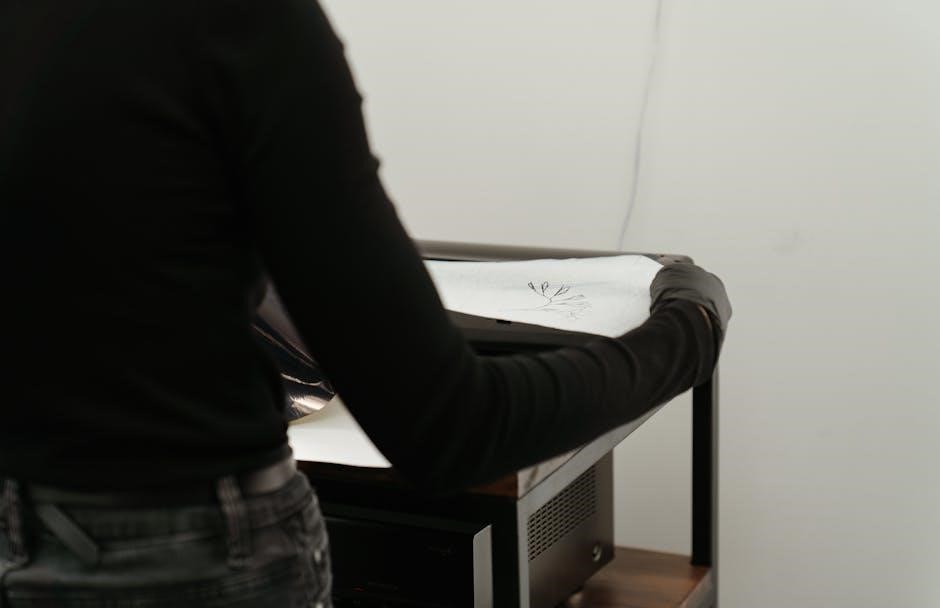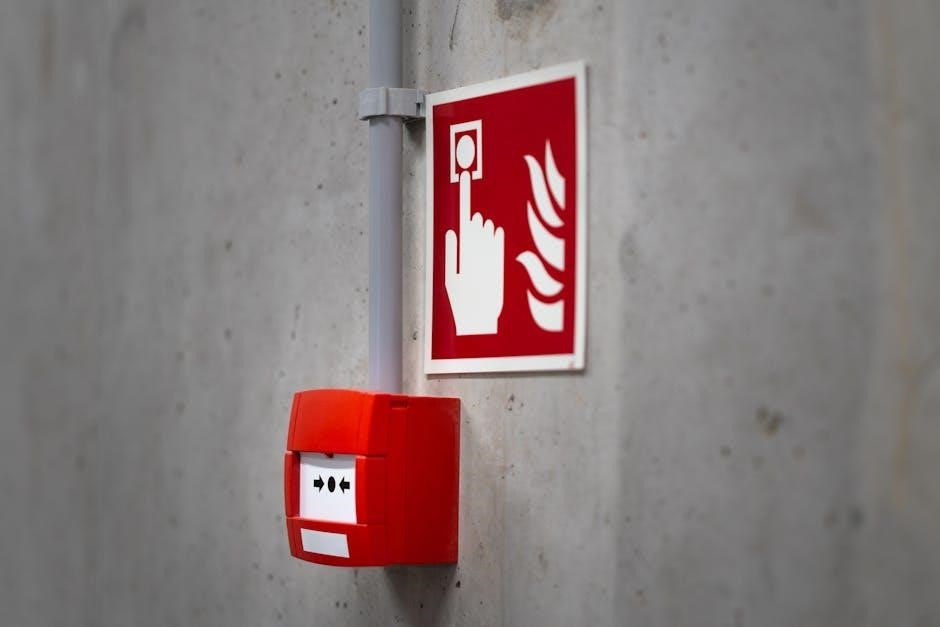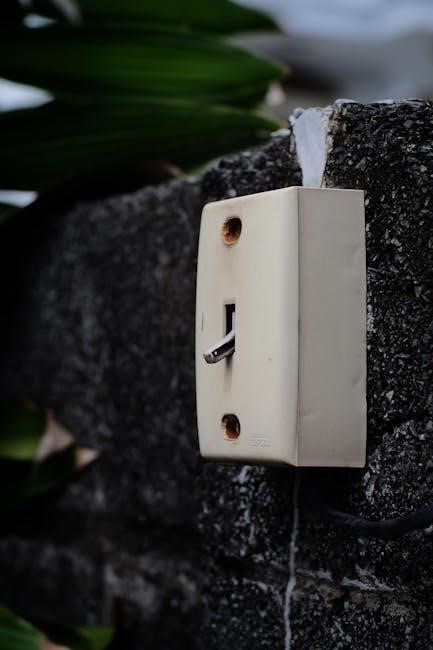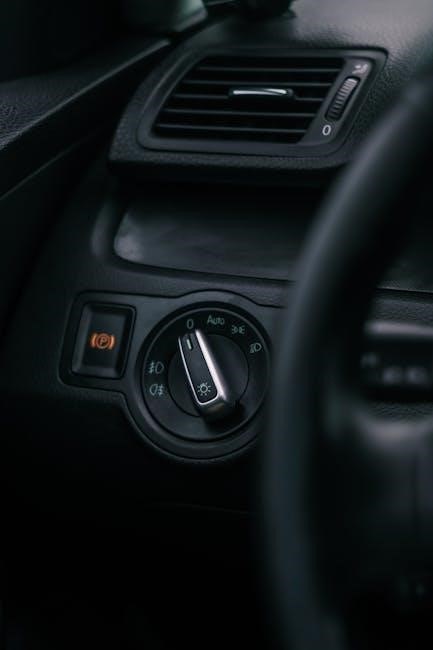A 50A manual transfer switch is a reliable solution for seamless power transitions between utility and generator sources, ensuring uninterrupted supply during outages with UL 1008 certification.
1.1 Definition and Purpose
A 50A manual transfer switch is a device designed to safely transition power between a utility grid and a portable generator during outages. Its primary purpose is to ensure uninterrupted electricity supply to essential circuits in homes or businesses. Rated for 50 amps, it can handle substantial power demands, making it ideal for systems requiring up to 12,500 watts. The switch is prewired for easy installation and features LED indicators to monitor active power sources. By preventing dangerous back-feeding and ensuring compliance with safety standards, it provides a reliable, efficient solution for backup power management. This device is crucial for maintaining functionality during emergencies, offering flexibility and peace of mind for users.
1;2 Importance of Manual Transfer Switches
Manual transfer switches are essential for ensuring safe and efficient power transitions during outages. They prevent dangerous back-feeding, which can damage equipment or harm utility workers. By providing a clear separation between utility and generator power, these switches eliminate the risk of electrical overloads. They also offer flexibility, allowing users to prioritize essential circuits and manage power distribution effectively. With a 50A rating, they can handle substantial loads, making them ideal for residential and small commercial applications. Their prewired design simplifies installation, reducing costs and downtime. UL 1008 certification ensures compliance with safety standards, providing peace of mind for users. This makes manual transfer switches a critical component in backup power systems, offering reliability and efficiency during emergencies.
1.3 Brief Overview of 50A Rating
The 50A rating on a manual transfer switch indicates its maximum electrical capacity, suitable for handling substantial power needs. This rating ensures compatibility with portable generators up to 12,500 watts, making it ideal for residential and small commercial use. The 50A capacity supports multiple circuits, allowing simultaneous operation of essential appliances like HVAC systems, water heaters, and lighting. Its design accommodates both 120/240V configurations, providing versatility for various electrical setups. This rating is a standard for backup power systems, offering a balance between flexibility and safety. It ensures reliable performance during outages while adhering to safety standards, making it a preferred choice for homeowners and businesses seeking efficient backup solutions.
Key Features of a 50A Manual Transfer Switch

A 50A manual transfer switch offers UL 1008 certification, prewired design for easy installation, LED indicators for power monitoring, and compatibility with portable generators up to 12,500 watts.
2.1 UL 1008 Certification
A 50A manual transfer switch with UL 1008 certification ensures compliance with rigorous safety standards for transfer switches. This certification verifies that the device can safely handle power transitions between utility and generator sources, preventing back-feeding and electrical hazards. UL 1008 testing includes evaluations for endurance, temperature rise, and fault current handling, guaranteeing reliable performance under various conditions. The certification also confirms that the switch meets national electrical codes, providing peace of mind for homeowners and businesses. By choosing a UL 1008-certified 50A manual transfer switch, users ensure a safe and efficient backup power solution during outages.

2.2 Prewired Design for Easy Installation
A key feature of the 50A manual transfer switch is its prewired design, which simplifies installation and reduces costs. The switch comes with labeled wires and pre-connected circuits, eliminating the need for complex wiring. This streamlined design ensures a faster and more efficient setup, making it accessible for DIY enthusiasts and professionals alike. The prewired system also minimizes the risk of wiring errors, ensuring safety and reliability. With this feature, users can quickly connect their generator to essential circuits, providing a seamless backup power solution during outages. The prewired design is a significant advantage, offering both convenience and cost-effectiveness for homeowners and businesses.
2.3 LED Indicator Lights for Power Source Monitoring
The 50A manual transfer switch features LED indicator lights that provide real-time monitoring of power sources. These lights clearly show whether the system is running on utility power, generator power, or both. The indicators ensure safe and efficient switching between sources, preventing potential hazards like back-feeding. With a quick glance, users can confirm the active power source, making operation intuitive and stress-free. This feature is especially crucial during outages, allowing homeowners to maintain control and visibility over their power supply. The LED lights enhance overall system reliability and user confidence, ensuring smooth transitions between utility and generator power seamlessly. This monitoring capability is a vital component of the switch’s design, offering peace of mind during emergencies.
2.4 Compatibility with Portable Generators
The 50A manual transfer switch is designed to seamlessly integrate with portable generators, offering a flexible and reliable backup power solution. It supports generators with 50A receptacles, ensuring compatibility with a wide range of models, including those from Generac and Champion. This feature allows homeowners to easily connect their portable generators, eliminating the need for multiple extension cords. The switch is prewired for quick setup, making it a convenient option for emergency power needs. Its compatibility with portable generators enhances its versatility, providing a cost-effective and efficient way to manage backup power during outages. This ensures safe and efficient power delivery to essential circuits, making it a practical choice for both residential and small commercial applications.
Installation Considerations
Ensure proper installation by a licensed electrician, following local codes. The prewired design simplifies setup, while the inlet box and compatibility with generators enhance safety and efficiency.
3.1 Step-by-Step Installation Guide
Begin by selecting a suitable location for the transfer switch, ensuring compliance with local electrical codes. Hire a licensed electrician to handle the installation. First, prepare the site by turning off the main power supply. Next, connect the generator inlet box to the transfer switch, ensuring proper wiring. Mount the switch near the main electrical panel for easy access. Connect the prewired circuits to the appropriate breakers, following the manufacturer’s instructions. Test the system by switching between utility and generator power to ensure smooth operation. Finally, inspect all connections and perform a safety check to confirm everything is functioning correctly.
3.2 Wiring Requirements and Recommendations
Proper wiring is crucial for safe and efficient operation of a 50A manual transfer switch. Use 10 AWG copper wires for generator connections, ensuring they are rated for 50A and 240V. Install a dedicated 50A GFCI-protected circuit for the generator inlet to prevent overloads. Connect the transfer switch to the main electrical panel, ensuring all wires are securely fastened and labeled. Avoid overloaded circuits by distributing power evenly across breakers. Use AFCI-compliant breakers for circuits handling sensitive electronics; Weatherproof wiring materials if installed outdoors. Follow NEC guidelines and local electrical codes to ensure compliance. Proper grounding is essential to prevent electrical hazards. Regularly inspect wires for damage or wear to maintain system integrity and safety.
3.3 Choosing the Right Location for Installation
Selecting the right location for a 50A manual transfer switch is critical for safety and functionality. Install it near the main electrical panel to minimize wiring complexity and costs. Ensure the switch is easily accessible for operation during emergencies. For outdoor installations, choose a location protected from direct rain and extreme weather conditions, using a NEMA 3R-rated enclosure. Indoors, place it in a dry, cool area away from potential water sources. Avoid areas prone to flooding or high humidity. Ensure compliance with local electrical codes and maintain a safe distance from flammable materials. Proper placement ensures reliable performance and adherence to safety standards, making power transitions seamless during outages.
Safety Features and Compliance
The 50A manual transfer switch ensures safety with AFCI and GFCI protection, preventing back-feeding and electrical hazards. It meets UL 1008 standards for reliable performance and compliance with electrical codes.
4.1 AFCI and GFCI Protection Requirements
The 50A manual transfer switch must incorporate AFCI (Arc Fault Circuit Interrupter) and GFCI (Ground Fault Circuit Interrupter) protection to ensure electrical safety. AFCI detects dangerous arcing conditions, preventing fires, while GFCI protects against ground faults, reducing shock risks. These features are crucial for compliance with modern electrical codes, especially in residential and commercial settings. Proper installation ensures these protections function correctly, safeguarding people and property from potential hazards. Regular testing of AFCI and GFCI devices is recommended to maintain reliability and uphold safety standards.
4.2 Prevention of Back-Feeding
Preventing back-feeding is critical when using a 50A manual transfer switch, as it ensures no electricity flows from the generator into the utility grid. This dangerous condition can harm utility workers and damage equipment. The switch achieves this by physically isolating the generator and utility power sources, ensuring they cannot be connected simultaneously. A mechanical interlock or electrical lockout feature prevents both sides from being energized at the same time. Proper installation and adherence to electrical codes are essential to maintain this safety. Back-feeding prevention is a legal and safety requirement, ensuring compliance with regulations and protecting both the user and the grid from potential hazards.
4.3 Compliance with Electrical Codes
Ensuring compliance with electrical codes is essential when installing a 50A manual transfer switch. These switches must meet standards like UL 1008, which governs transfer equipment for use in electrical power systems. Compliance ensures safety, reliability, and adherence to local and national electrical regulations. Proper installation by a licensed electrician is crucial to maintain code compliance, preventing hazards and legal issues. The switch must integrate with GFCI and AFCI protections, as required by modern electrical codes. Regular inspections and adherence to manufacturer guidelines further ensure ongoing compliance. By meeting these standards, the 50A manual transfer switch provides a safe and legally approved solution for backup power management.

Applications of 50A Manual Transfer Switch
The 50A manual transfer switch is ideal for residential and commercial use, providing reliable backup power during outages. It suits both indoor and outdoor installations, ensuring safe and efficient power transitions for essential circuits and appliances.
5.1 Residential Use
The 50A manual transfer switch is widely used in residential settings to provide reliable backup power during outages. It eliminates the need for multiple extension cords by directly connecting a portable generator to the home’s electrical panel. This setup allows homeowners to power essential circuits, such as lighting, HVAC systems, water heaters, and kitchen appliances. The switch is designed to safely manage the transition between utility and generator power, ensuring no back-feeding occurs. Its prewired design and compatibility with generators up to 12,500 watts make it a practical solution for homeowners seeking convenience and efficiency. UL 1008 certification further ensures safety and reliability for residential applications.
5.2 Commercial Use
The 50A manual transfer switch is a versatile solution for commercial applications, providing reliable backup power during outages. It is ideal for small to medium-sized businesses, such as retail stores, offices, and restaurants, where uninterrupted power is crucial. The switch allows seamless transition between utility and generator power, ensuring critical systems like lighting, HVAC, and security remain operational. Its compatibility with portable generators and prewired design make it a cost-effective option for businesses seeking to minimize downtime. Additionally, the switch’s durability and outdoor-rated options ensure it can withstand harsh environments, making it suitable for industrial or outdoor commercial settings. This ensures business continuity and safety, aligning with commercial electrical needs.
5.3 Outdoor and Indoor Ratings
The 50A manual transfer switch is designed to accommodate both outdoor and indoor installations, offering flexibility for various applications. Outdoor-rated models feature weather-resistant enclosures, such as NEMA 3R, ensuring durability in harsh conditions like rain, snow, and extreme temperatures. Indoor-rated switches are ideal for residential and commercial settings, providing a safe and compact solution for backup power management. Both options are built with safety and reliability in mind, meeting UL 1008 certification standards. Whether installed outside or inside, the switch ensures seamless power transitions and protects against electrical hazards, making it a versatile choice for diverse environments and power needs.

Troubleshooting Common Issues
Common issues include the switch not activating during outages, requiring a 240V generator signal for operation, and ensuring AFCI/GFCI compliance to prevent electrical hazards.

6.1 Switching Between Power Sources
Switching between utility and generator power with a 50A manual transfer switch requires careful steps to ensure safety and functionality. First, confirm the generator is operational and producing 240V. Next, turn off all connected loads to prevent overloading. Flip the switch to the generator position, ensuring it clicks securely. Verify the LED indicators show the generator is active. If issues arise, check for proper wiring and AFCI/GFCI compliance. Some switches may not activate without detecting a power outage, so manual override features or specific adapter cables might be necessary. Always follow manufacturer guidelines to avoid back-feeding risks and ensure smooth transitions.
6.2 Handling Overload Situations
Handling overload situations with a 50A manual transfer switch involves monitoring power consumption and managing connected loads. If the switch detects an overload, it may trip the breaker or indicate the issue via LED lights. To resolve this, prioritize essential circuits and disconnect non-critical appliances. Ensure the generator’s capacity matches the total load to prevent frequent overloads. Regularly inspect wiring and connections to avoid resistance-related issues. If overloads persist, consider upgrading to a higher-rated switch or redistributing loads across multiple circuits. Always follow the manufacturer’s guidelines for safe operation and refer to the installation manual for specific overload handling procedures.
6.3 Diagnosing Electrical Faults
Diagnosing electrical faults in a 50A manual transfer switch involves checking for common issues like tripped breakers, loose connections, or faulty indicator lights. Start by ensuring the switch is properly installed and all wires are securely connected. If the LED indicators show unusual patterns, refer to the user manual for troubleshooting codes; Check for overloaded circuits by monitoring the amperage draw. Verify that the generator is producing the correct voltage and frequency. If issues persist, inspect the switch’s internal components for damage or wear. Consult a licensed electrician if problems are complex or recurring. Regular maintenance and inspections can help prevent faults and ensure reliable operation during power outages.

Maintenance and Upkeep
Regular inspection and cleaning of the 50A manual transfer switch ensure optimal performance. Lubricate moving parts annually and replace worn components as needed. Follow manufacturer guidelines for reliability and safety.
7.1 Regular Inspection Checklist
A regular inspection checklist for a 50A manual transfer switch ensures optimal functionality and safety. Start by verifying UL 1008 certification for compliance. Inspect all wires for damage, fraying, or loose connections. Check the LED indicator lights to ensure they function correctly, providing clear power source monitoring. Test the switch mechanism for smooth operation and verify compatibility with your portable generator. Review the prewired design for any signs of wear or overheating. Ensure the enclosure is secure and free from environmental damage. Finally, consult the manufacturer’s guidelines for any model-specific checks. Regular inspections prevent potential issues and ensure reliable performance during power outages.
7.2 Cleaning and Lubrication
Regular cleaning and lubrication are essential for maintaining the performance and longevity of a 50A manual transfer switch. Start by turning off the power supply before cleaning. Use a soft, dry cloth to wipe down the exterior and internal components, removing dust and debris. Inspect the switch contacts and wires for dirt or corrosion, gently cleaning them with a fine brush or compressed air. Apply a small amount of silicone-based lubricant to moving parts, such as the switch mechanism, to ensure smooth operation. Avoid using harsh chemicals or excessive lubrication, as this may damage the components. Clean the LED indicator lights to maintain visibility. Lubricate the switch every 6-12 months or as recommended by the manufacturer. Always refer to the user manual for specific cleaning and lubrication guidelines for your model.
7.3 Replacement of Worn-Out Parts
Replacing worn-out parts in a 50A manual transfer switch is crucial for maintaining its functionality and safety. Regularly inspect components like switches, circuit breakers, and wires for signs of wear or damage. If a part is damaged, replace it immediately to prevent electrical hazards. Use genuine or compatible replacement parts to ensure proper operation. When replacing, always disconnect the power supply and follow the manufacturer’s instructions. Clean the area before installing new parts to avoid contamination. For complex replacements, such as the main switch or circuit breakers, consult a licensed electrician. Keep a record of replacements for future reference and to ensure compliance with safety standards. Regular maintenance helps extend the lifespan of the transfer switch and ensures reliable performance during power outages.

Cost and Budgeting
The 50A manual transfer switch typically costs between $400-$700 for hardware, with labor fees adding another $500-$700, offering long-term savings through reliable backup power solutions.
8.1 Hardware Costs
The hardware costs for a 50A manual transfer switch typically range between $400 and $700, depending on the brand and features. A basic 50A transfer switch kit, including a 25-foot cord and outdoor-rated inlet, can cost around $500. High-end models with additional features like LED indicators or prewired designs may cost closer to $700. Some users have reported finding parts like inlet boxes and wiring for less than $400, but these often require separate purchases. The overall cost remains reasonable, considering the reliability and safety these switches provide for backup power solutions. Prices may vary based on the manufacturer and specific functionalities offered.
8.2 Labor Costs for Installation

Labor costs for installing a 50A manual transfer switch can range from $700 to $1,000, depending on the electrician’s rates and location. Some users have reported paying around $700 for both the switch and receptacle box installation. Factors such as the complexity of the setup, the need for additional wiring, and local labor rates influence the final cost. In some cases, prewired designs may reduce labor expenses, as they simplify the installation process. It’s essential to obtain quotes from multiple licensed electricians to find the best balance of quality and affordability. Proper installation ensures safety and compliance with electrical codes, making it a worthwhile investment for reliable backup power solutions.
8.3 Long-Term Savings and Benefits
Investing in a 50A manual transfer switch offers significant long-term savings and benefits. By eliminating the need for multiple extension cords, it reduces the risk of electrical hazards and potential fires, lowering insurance costs. The prewired design simplifies installation, cutting labor expenses and ensuring a safer setup. Over time, the switch’s durability and reliability minimize the need for frequent repairs or replacements, saving money on maintenance. Additionally, it provides peace of mind during power outages by ensuring a seamless transition to generator power, protecting sensitive electronics and preventing data loss. The switch’s compliance with safety standards like UL 1008 further enhances its long-term value, making it a cost-effective solution for backup power management.
Future Trends and Innovations
The future of 50A manual transfer switches lies in smart technology integration, enabling remote monitoring and automatic switching. Innovations like renewable energy compatibility and advanced safety features are expected to enhance efficiency and scalability.
9.1 Smart Transfer Switches
Smart transfer switches represent the next evolution in power management, offering advanced features like remote monitoring and automatic switching. These intelligent systems integrate seamlessly with renewable energy sources, optimizing efficiency and reliability. By incorporating IoT technology, users can control and monitor power transitions via smartphones or tablets, ensuring real-time updates and enhanced safety. Smart switches also enable predictive maintenance, reducing downtime and extending equipment lifespan. Their ability to adapt to varying power demands makes them ideal for both residential and commercial applications. As technology advances, smart transfer switches are poised to become the standard, providing unparalleled convenience and efficiency for 50A manual transfer switch users.
9.2 Integration with Renewable Energy Systems
The integration of 50A manual transfer switches with renewable energy systems, such as solar or wind power, offers a sustainable solution for backup power management. These switches enable seamless transitions between renewable energy sources, utility power, and generators, ensuring continuous energy supply. By incorporating renewable energy, users can reduce reliance on fossil fuels and lower energy costs. Smart systems optimize energy use by prioritizing renewable sources when available. This integration enhances energy efficiency and supports eco-friendly power solutions. The prewired design of 50A manual transfer switches simplifies installation with renewable systems, while UL certification ensures safety and compliance with electrical standards.
9.3 Automatic Transfer Switches vs. Manual
Automatic transfer switches (ATS) and manual transfer switches differ in operation and convenience. ATS automatically switches between power sources without manual intervention, ideal for critical applications requiring uninterrupted power. Manual switches require physical operation, offering simplicity and cost-effectiveness for smaller setups. ATS is faster, reducing downtime, while manual switches rely on user action, which may delay transitions. Both ensure safe power transfer, but ATS is preferred for commercial or high-reliability needs, whereas manual switches suffice for residential use. Cost-wise, manual switches are more affordable, while ATS involves higher initial and maintenance expenses due to complex mechanisms. Choose based on specific power requirements and budget constraints.
A 50A manual transfer switch is a reliable solution for seamless power transitions, offering UL certification, prewired design, and LED indicators for easy installation and monitoring, ensuring safety and efficiency.
10.1 Summary of Key Points
The 50A manual transfer switch is a UL 1008 certified device designed for safe and efficient power transitions between utility and generator sources. It features a prewired design for easy installation, LED indicators for monitoring power sources, and compatibility with portable generators. Ideal for residential and commercial use, it supports both indoor and outdoor applications. The switch prevents back-feeding and ensures compliance with AFCI and GFCI requirements. Regular maintenance, including inspections and part replacements, is essential for optimal performance. With hardware and labor costs varying, it offers long-term savings by providing reliable backup power. Future innovations may include smart switches and integration with renewable energy systems, enhancing functionality and efficiency.

10.2 Final Thoughts on 50A Manual Transfer Switch
The 50A manual transfer switch is a practical and essential solution for ensuring reliable backup power during outages. Its prewired design and UL 1008 certification make it a safe and efficient choice for both residential and commercial applications. The ability to monitor power sources with LED indicators and prevent back-feeding adds to its safety features. While installation costs may vary, the long-term benefits of uninterrupted power supply make it a worthwhile investment. As technology advances, integrating smart features and renewable energy compatibility will further enhance its value. Overall, it remains a dependable option for seamless power transitions, providing peace of mind during unexpected power disruptions.
